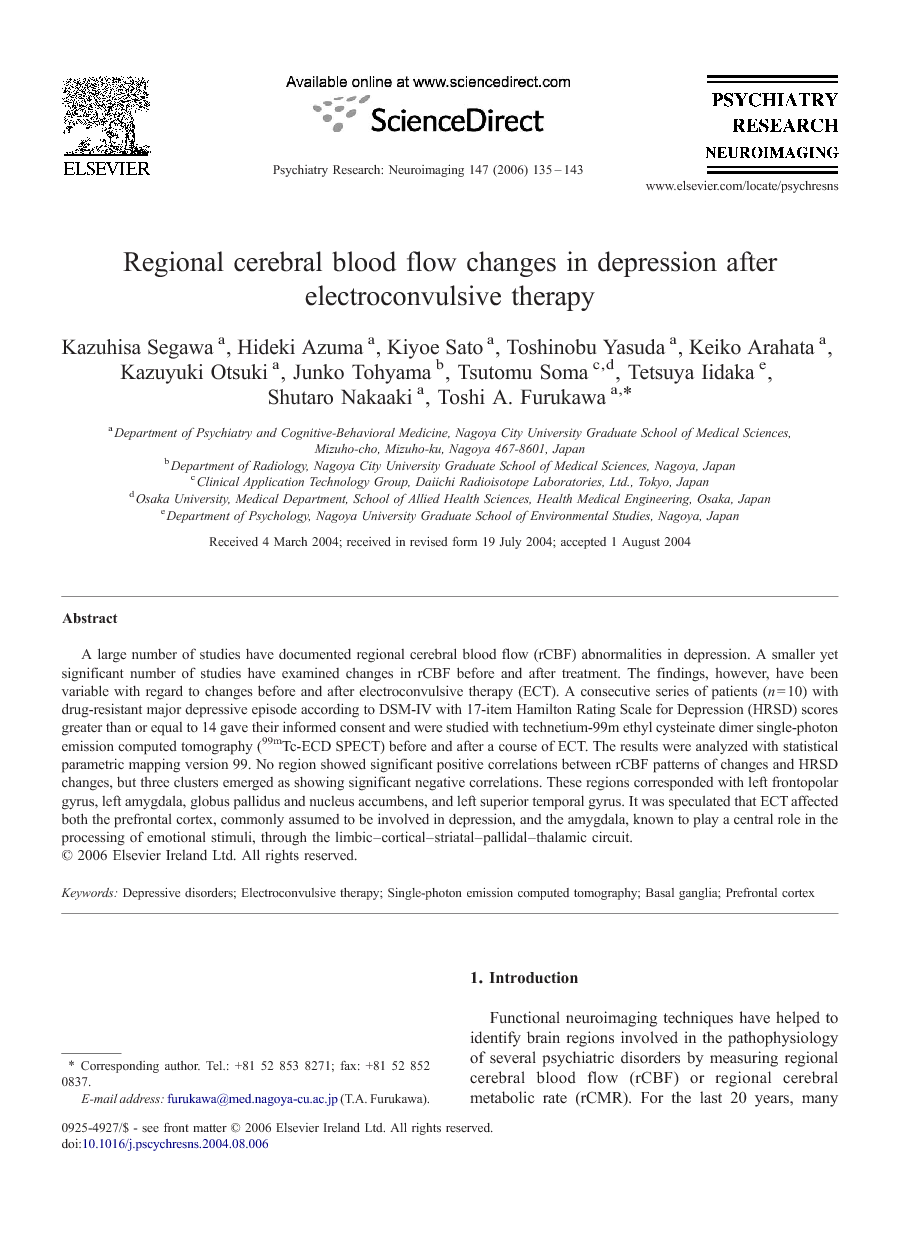Austin et al., 1992, Bench et al., 1993, Mayberg et al., 1994 and Awata et al., 2002), the temporal region (Austin et al., 1992 and Mayberg et al., 1994), the parietal region (Austin et al., 1992 and Bonne et al., 2003) and the cingulate gyrus (Bench et al., 1993 and Mayberg et al., 1994). Others have reported no significant change (Maes et al., 1993) or increased rCBF in the frontal (Tutus et al., 1998 and Abou-Saleh et al., 1999) and parietal (Abou-Saleh et al., 1999) cortical regions, the hippocampus (Videbech et al., 2001), the amygdala (Hornig et al., 1997), the thalamus (Drevets et al., 1992), the pallidum, the putamen (MacHale et al., 2000), and the cerebellum (Videbech et al., 2001).
Electroconvulsive therapy (ECT) is widely used to treat depressed patients and is considered to be a rapidly acting, effective therapy (UK ECT Review Group, 2003). It is especially indicated for patients who have not responded to conventional antidepressant therapies. A number of studies have examined the effect of a course of ECT on rCBF or rCMR, using SPECT or PET (Nobler et al., 1994, Bonne et al., 1996, Mervaala et al., 2001, Awata et al., 2002 and Vangu et al., 2003), but the findings have been variable. Studies of the effect of ECT can be classified into three categories depending on the timing of CBF or CMR during the treatment course (Nobler and Sackeim, 1998): during seizure activity (ictal effect), seconds to several hours after the last ECT or a single ECT in a series (post-ictal effect or the short-term effect), and several days or more after the last ECT (the long-term effect). Studies of the ictal effect have reported differential regional increases and decreases in CBF or CMR (Elizagarate et al., 2001 and Blumenfeld et al., 2003). Studies of the short-term effect have consistently reported CBF reductions (Scott et al., 1994 and Nobler et al., 1994). However, studies of the long-term effect have resulted in inconsistent findings up to now. Nobler et al. demonstrated that their treatment-responsive patients showed greater reductions of rCBF (Nobler et al., 1994) and rCMR (Nobler et al., 2001) in some regions after a course of ECT. Awata et al. also showed that an rCBF reduction in some regions persisted for several weeks after ECT in voxel-by-voxel analyses (Awata et al., 2002). On the other hand, Bonne et al. reported that ECT increased blood flow in several regions of the brain (Bonne et al., 1996), and Mervaala et al. also reported increased perfusion after ECT in two cortices (Mervaala et al., 2001). According to Milo et al., only patients responsive to ECT showed changes toward normal in rCBF (Milo et al., 2001). In Vangu et al.'s study, all except one patient who responded to ECT showed increased cerebral perfusion as ascertained visually (Vangu et al., 2003). Finally Yatham et al. found no statistically significant differences between pretreatment and posttreatment in CMR (Yatham et al., 2000).
This much variability of findings in the changes of rCBF or rCMR in depressed patients receiving ECT treatment may stem from several sources, including differences in patients' diagnostic and demographic characteristics, differences in imaging techniques and the timing of the scan within the treatment course, and choices of control subjects. Differences in statistical analysis methods (region-of-interest vs. voxel-wise) seem to be another factor that may have contributed to variability of rCBF findings (Bonne et al., 2003). In recent years, statistical parametric mapping (SPM) (Friston et al., 1995) is increasingly used as an objective, whole-brain analysis technique. Among the studies on rCBF or rCMR after ECT reviewed above, only four studies used SPM analysis (Nobler et al., 2001, Awata et al., 2002, Blumenfeld et al., 2003 and Bonne et al., 2003). This approach is preferable because it makes no assumptions about the location of significance and can compare cerebral perfusion between PET or SPECT scans on a voxel-by-voxel basis.
It is clinically important to measure rCBF changes in depressed patients before and after ECT because rCBF may provide important information about the brain regions involved in depression and the neural mechanisms of the action of ECT, and may identify specific biological markers capable of predicting therapeutic response. Based on these considerations, we studied a consecutive series of depressed patients who were referred for ECT in our Department of Psychiatry, with technetium-99m ethyl cysteinate dimer (99mTc-ECD) SPECT before and after a course of ECT, and with SPM99. The aims of the study were to examine the long-term effect of ECT, i.e. the association between the changes in rCBF patterns and the improvement of depressive symptoms after a course of ECT had been completed. Examining this association, a few studies found that a decrease in the CBF or CMR of the frontal region was positively correlated with the antidepressant effect of ECT (Nobler et al., 1994 and Henry et al., 2001). However, previous findings were inconsistent regarding the laterality effect of rCBF changes in the frontal lobe following ECT. While some neuroimaging studies using Xenon SPECT and FDG PET have reported a reduction in rCBF on the right side of the frontal lobe (Silfverskiold et al., 1986, Nobler et al., 1994 and Henry et al., 2001), other studies using FDG PET/SPECT reported a reduction or increase in rCBF on the bilateral or left side of the frontal lobe (Nobler et al., 2001 and Vangu et al., 2003).


